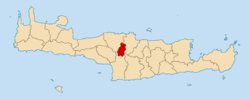Anogeia
|
Anogeia Ανώγεια |
|
|---|---|

Landscape around Anogeia
|
|
| Coordinates: 35°17′N 24°53′E / 35.283°N 24.883°ECoordinates: 35°17′N 24°53′E / 35.283°N 24.883°E | |
| Country | Greece |
| Administrative region | Crete |
| Regional unit | Rethymno |
| Area | |
| • Municipality | 102.6 km2 (39.6 sq mi) |
| Elevation | 738 m (2,421 ft) |
| Population (2011) | |
| • Municipality | 2,379 |
| • Municipality density | 23/km2 (60/sq mi) |
| Time zone | EET (UTC+2) |
| • Summer (DST) | EEST (UTC+3) |
| Vehicle registration | ΡΕ |
Anogeia (Ανώγεια) is a municipality in the Rethymno regional unit, Crete, Greece. The municipality has an area of 102.632 km2 (39.626 sq mi). Population 2,379 (2011).
When exactly Anogeia was founded and by whom, is not accurately known. Many believe that the original settlement was founded by villagers from the village Axos, which is located west of Anogia, at the location where the Minoan city Oaxos was situated.
According to a legend, a shepherd from Axos found one day on one of the slopes of Psiloreitis an icon depicting Saint John the Baptist. Pious as he was, he picked it up carefully, wrapped it in a towel, took it to his home and placed it there alongside the other icons. On the following day he was astonished to find out that the icon had disappeared. Terrified, he went back to the place he had found it on the day before, where he was exhilarated to discover that the icon was exactly at the same location. This inexplicable phenomenon was considered to be an order from the heavens, to build at that exact location a temple dedicated to Saint John the Baptist.
The church of Saint John seems to be the first building of the settlement, which later came to be known as “Anogia”. Within the temple of Saint John are remains of Byzantine drawings on the walls, which can be dated back to the 11th century.
The historian Stelios Spanakis, summarily provides geographical, as well as historical information about Anogia,: “Anogia is a town –municipality in the Mylopotamos Province of the Prefecture of Rethymno. In the 1981 census it numbered 2.449 citizens. It is located in the northern reaches of Psiloreitis, at an altitude of 700-790 meters. When in 1182 Crete was divided among the 12 Young Princes of Byzantium, Anogia were given to the family of Fokas. Anogia are referred to by Venetian and Greek scholars and historians as Anogia, or Anoia. In 1593 it was already a significant settlement, numbering 911 citizens. Anogia are referred to as a revolutionary place during the years of Turkish occupation. In 1822, when the Anogians were fighting the Turks in Messara, Serif Pasha found the village empty and put it to the torch. In November 1866, when the Arkadi Monastery was being burned, Resit Pasha tried to capture Anogia, but he was repulsed by the Anogians and other villagers from Mylopotamos.” This tradition continued during the German occupation and in August 1944 the village was once again razed to the ground in reprisal for the local's participation in the resistance.
...
Wikipedia


